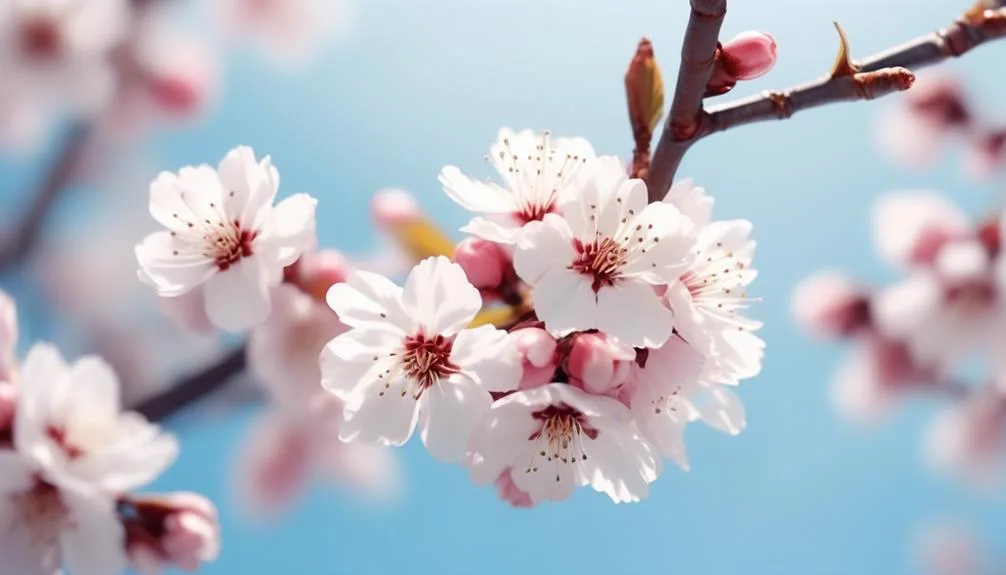As you wander through a cherry blossom garden and admire the beautiful pink petals swaying in the wind, you might wonder why these trees put so much effort into showcasing their blossoms. The reason behind cherry trees' showy blossoms is not just about looking pretty.
It's a fascinating mix of natural selection, ecological strategy, and cultural significance. There's a whole world of wonder behind those enchanting blooms, waiting to be discovered once you start exploring.
Cherry Blossom Significance
Discover the rich cultural and symbolic significance of cherry blossoms, which hold deep meaning in various traditions and societies around the world.
The delicate, fleeting beauty of cherry blossoms has been celebrated for centuries, symbolizing the ephemeral nature of life and the beauty of fleeting moments.
In Japan, cherry blossoms, or sakura, are revered for their symbolism of renewal, the transient nature of life, and the arrival of spring. The annual cherry blossom festivals, known as Hanami, attract millions of locals and tourists who gather under the blooming trees to celebrate the beauty of the blossoms. These celebrations often include traditional Japanese performances, food, and music.
Additionally, cherry blossoms are a popular subject in photography, capturing their stunning beauty and evoking a sense of awe and wonder.
Pollination and Reproduction
Amidst the cultural and symbolic significance of cherry blossoms, the process of pollination and reproduction plays a vital role in perpetuating the fleeting beauty that captivates admirers worldwide.
Cherry trees rely on pollinators, such as bees and butterflies, to transfer pollen from the male reproductive parts of one flower to the female parts of another. This essential process kickstarts the reproductive cycle, leading to the development of fruit.
The genetic diversity of cherry trees is maintained through this intricate dance of pollination, ensuring the resilience of the species.
The flowering season marks the beginning of this journey, as delicate blossoms emerge, attracting pollinators and signaling the start of fruit production.
As the petals fall, the promise of a bountiful harvest begins to take shape, all thanks to the intricate dance of pollination and reproduction.
Attracting Pollinators
To attract pollinators, cherry trees rely on their delicate blossoms to entice bees and butterflies to facilitate the crucial process of pollination and reproduction. The floral display of cherry trees is a strategic and captivating spectacle designed to attract pollinators.
The sweet fragrance and vibrant colors of the blossoms act as a signal to pollinators, inviting them to partake in the nectar and pollen within. Pollinator behavior is influenced by various factors, including the visual appeal of the flowers and the scent they emit.
Bees and butterflies are drawn to the cherry blossoms, flitting from flower to flower in search of sustenance, inadvertently transferring pollen and promoting the trees' reproductive cycle.
The intricate relationship between cherry trees and their pollinators highlights the importance of the trees' showy blossoms in ensuring successful pollination and fruit production.
Environmental Adaptations
Cherry trees' ability to attract pollinators through their blossoms demonstrates their remarkable environmental adaptations to ensure successful reproduction and fruit production. These adaptations enable cherry trees to thrive in various climates and survive seasonal changes. The table below highlights some of the key environmental adaptations of cherry trees, showcasing their climate resilience and survival strategies.
| Environmental Adaptation | Description | Importance |
|---|---|---|
| Dormancy | Entering a dormant phase during | Protects from extreme temperatures. |
| winter to conserve energy. | ||
| Flowering Time | Blooming in early spring to | Synchronizes with pollinators' activity. |
| maximize pollination. | ||
| Root System | Developing deep, extensive roots | Enhances water absorption and stability. |
| for stability and water uptake. | ||
| Leaf Shedding | Shedding leaves in fall to | Prevents water loss and conserves energy. |
| conserve resources. |
Cherry trees' environmental adaptations equip them to not only withstand environmental challenges but also to thrive and reproduce successfully.
Cultural and Aesthetic Value
With their vibrant blossoms and rich cultural symbolism, cherry trees hold a significant place in various traditions and artistic expressions around the world.
The cultural symbolism of cherry blossoms varies across different societies, but they're generally associated with themes of renewal, beauty, and the transient nature of life.
In Japan, the annual tradition of hanami, or flower viewing, draws millions of people to admire the fleeting beauty of cherry blossoms. The delicate and ephemeral nature of the blossoms serves as a poignant reminder of life's transient beauty.
In addition to their cultural significance, cherry blossoms also hold great aesthetic value. Their stunning display of pink and white blooms attracts visitors from around the globe, making them a seasonal attraction in many countries and a popular subject in various art forms.
Conclusion
In appreciating cherry blossoms, we acknowledge their dual significance – not only for their visual appeal but also for their vital role in sustaining the cherry tree's existence.
These blooms serve as a beacon for pollinators and embody cultural and aesthetic value.
Let's value them for their beauty and ecological importance, fostering a deeper connection with nature.

My interest in trees started when I first saw the giant sequoias in Yosemite.
I was a teenager then, and I remember thinking, “I need to learn more about this.”
That moment stuck with me.
A few years later, I went on to study forestry at Michigan Tech.
Since graduating, I’ve worked in a mix of hands-on tree care and community education.
I’ve spent over ten years helping people understand how to plant, maintain, and protect the trees in their neighborhoods.
I don’t see trees as just part of the landscape.
They are living things that make a real difference in our daily lives.
